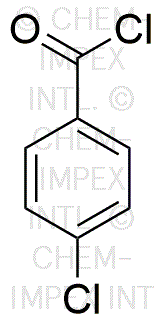4-Chlorobenzoyl chloride is widely utilized in research focused on:
- Synthesis of Pharmaceuticals: This compound serves as an important intermediate in the production of various pharmaceuticals, enhancing the development of medications by facilitating the introduction of chlorobenzoyl groups into drug molecules.
- Production of Agrochemicals: It is used in the synthesis of herbicides and pesticides, providing effective solutions for crop protection and improving agricultural productivity.
- Polymer Chemistry: The compound plays a significant role in the synthesis of specialty polymers, contributing to the development of materials with tailored properties for specific applications.
- Laboratory Reagents: As a reactive acyl chloride, it is utilized in organic synthesis as a reagent for acylation reactions, making it essential for researchers in organic chemistry.
- Manufacturing of Dyes and Pigments: It is employed in the production of various dyes and pigments, enhancing colorfastness and stability in textile and coating applications.
General Information
Properties
Safety and Regulations
Applications
4-Chlorobenzoyl chloride is widely utilized in research focused on:
- Synthesis of Pharmaceuticals: This compound serves as an important intermediate in the production of various pharmaceuticals, enhancing the development of medications by facilitating the introduction of chlorobenzoyl groups into drug molecules.
- Production of Agrochemicals: It is used in the synthesis of herbicides and pesticides, providing effective solutions for crop protection and improving agricultural productivity.
- Polymer Chemistry: The compound plays a significant role in the synthesis of specialty polymers, contributing to the development of materials with tailored properties for specific applications.
- Laboratory Reagents: As a reactive acyl chloride, it is utilized in organic synthesis as a reagent for acylation reactions, making it essential for researchers in organic chemistry.
- Manufacturing of Dyes and Pigments: It is employed in the production of various dyes and pigments, enhancing colorfastness and stability in textile and coating applications.
Documents
Safety Data Sheets (SDS)
The SDS provides comprehensive safety information on handling, storage, and disposal of the product.
Product Specification (PS)
The PS provides a comprehensive breakdown of the product’s properties, including chemical composition, physical state, purity, and storage requirements. It also details acceptable quality ranges and the product's intended applications.
Certificates of Analysis (COA)
Search for Certificates of Analysis (COA) by entering the products Lot Number. Lot and Batch Numbers can be found on a product’s label following the words ‘Lot’ or ‘Batch’.
*Catalog Number
*Lot Number
Certificates Of Origin (COO)
This COO confirms the country where the product was manufactured, and also details the materials and components used in it and whether it is derived from natural, synthetic, or other specific sources. This certificate may be required for customs, trade, and regulatory compliance.
*Catalog Number
*Lot Number
Safety Data Sheets (SDS)
The SDS provides comprehensive safety information on handling, storage, and disposal of the product.
DownloadProduct Specification (PS)
The PS provides a comprehensive breakdown of the product’s properties, including chemical composition, physical state, purity, and storage requirements. It also details acceptable quality ranges and the product's intended applications.
DownloadCertificates of Analysis (COA)
Search for Certificates of Analysis (COA) by entering the products Lot Number. Lot and Batch Numbers can be found on a product’s label following the words ‘Lot’ or ‘Batch’.
*Catalog Number
*Lot Number
Certificates Of Origin (COO)
This COO confirms the country where the product was manufactured, and also details the materials and components used in it and whether it is derived from natural, synthetic, or other specific sources. This certificate may be required for customs, trade, and regulatory compliance.


